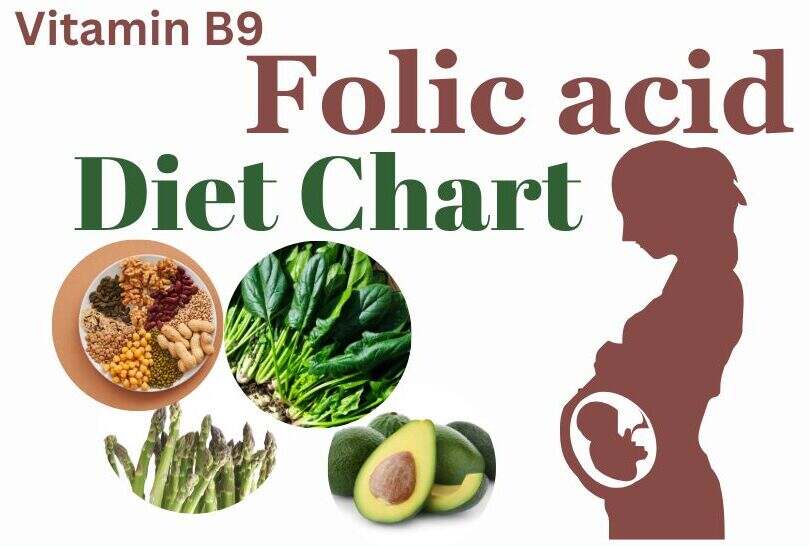- Vitamin B9, known by two names – folic acid and folate, is a vital nutrient, your body can’t live without this.
- It plays a significant role in cell growth, DNA synthesis, and the production of red blood cells Skin, and Hair.
Benefits of Folic Acid
- DNA Synthesis and Cell Division:- Vitamin B9 is essential for the synthesis and repair of DNA, our genetic material.
- Red Blood Cell Production:- Vitamin B9 aids in the production of red blood cells, preventing anemia.
- It helps in the formation of haemoglobin, (the protein responsible for carrying oxygen in the blood.)
- Pregnancy Protector:- During pregnancy, it helps prevent neural tube defects, such as spina bifida, in developing fetuses.
- Mental Health Manager: – Vitamin B9 can help boost your mood. It plays a role in producing serotonin, a chemical in your brain that makes you feel happy.
- Heart’s Best Friend:- It helps lower levels of homocysteine,( a compound that can damage your blood vessels and lead to heart problems. )
- Skin and Hair Saver:- Folate is involved in the production of new skin cells and hair follicles, keeping your appearance vibrant.
Daily Requirement of Folic Acid
The following are the recommended dietary allowances (RDAs) for folate/folic acid:
| Age Group | Recommended Daily Intake |
|---|---|
| Infants (0-6 months) | 65 mcg |
| Infants (7-12 months) | 80 mcg |
| Children (1-3 years) | 150 mcg |
| Children (4-8 years) | 200 mcg |
| Children (9-13 years) | 300 mcg |
| Adolescents (14-18 years) | 400 mcg |
| Adults (19+ years) | 400 mcg |
| Pregnant Women | 600-800 mcg |
| Lactating Women | 500-700 mcg |
Rich Diet Sources of Vitamin B9
- 1. Leafy Green Vegetables:- Spinach, kale, collard greens, and turnip greens, Dark, leafy greens are the best sources of vitamin B9 (folic acid). One cup of cooked spinach provides approximately 263 mcg of folic acid.
- 2. Legumes:- Lentils, chickpeas, black beans, and pinto beans are rich in folic acid. One cup of cooked lentils contains about 358 mcg of vitamin B9.
- 3. Asparagus:- Half a cup of cooked asparagus offers around 134 mcg of Folic acid. It’s also a good source of vitamins A, C, and K.
- 4. Avocado:- One medium-sized avocado contains approximately 163 mcg of Folate acid.
- 5. Eggs: One large egg contains about 24-30 mcg. of folic acid.
- 6. Meats:- In Liver: A 100-gram serving of liver contains approximately 260-290 mcg.
- 6. Seafood:- For example, cooked salmon provides approximately 7-10 mcg of folic acid per 100 grams.
Deficiency Disorder lack of Folic acid
- Megaloblastic Anemia.
- Neural Tube Defects in the fetus.
- Birth defects, including cleft lip and palate, heart defects, and limb abnormalities.
- Poor Growth in Infants and Children.
- Folic acid deficiency can lead to gastrointestinal symptoms, such as diarrhea, loss of appetite, and weight loss.
- Increased risk of cardiovascular problems, including heart disease and stroke.
Treatment:-
- Increasing intake of these foods can help replenish Folic acid levels.
- Doctors may recommend folic acid supplements. These supplements are available over-the-counter and are generally safe to use.
- Prenatal care: Regular check-ups and tests of Pregnant women.
Commonly asked questions-
Q.1. What is the difference between folic acid and folate?
- Ans.1.- Folic acid is the synthetic form of folate.
- Folate is the natural vitamin found in foods, while folic acid is made in labs and used in supplements and fortified foods.
- Folic acid is not as easily absorbed by our bodies as folate. Some people may have trouble converting folic acid into a usable form.
- Both help our bodies make DNA and important molecules. Folate from food may have extra health benefits beyond folic acid.
Q.2. What does folic acid do for pregnancy?
Ans.- Folic acid helps prevent birth defects in babies. It helps to strengthen the baby’s spine and brain to develop properly. It also helps make red blood cells for both the mom and the baby.
Q.3. Folic acid deficiency symptoms?
Ans. – Tiredness, Weakness, Pale skin, Shortness of breath, Irritability, Headaches, Heart palpitations. Trouble concentrating, Mouth sores, and Poor growth in kids.
Q.4. Difference between Methyl folate and folic acid?
Ans.- Methyl folate and folic acid are both forms of vitamin B9, but they have some important differences: –
- Form: Methyl folate is the active and natural form of vitamin B9, while folic acid is a synthetic form that needs to be converted in the body.
- Absorption: Methyl folate is easier to absorb. Folic acid requires a conversion process to absorb.
- Effectiveness: Some people, due to genetic factors or certain medical conditions, have a hard time converting folic acid into methyl folate. For these individuals, taking methyl folate directly can be more effective.
- Supplementation: Folic acid is commonly used in supplements and added to fortified foods because it’s cheaper and more stable. Methyl folate supplements are also available but may be more expensive.
- Medical Reasons: In some medical conditions, like certain genetic mutations (MTHFR gene mutations), methyl folate might be recommended over folic acid to ensure proper vitamin B9 levels in the body.
- Methyl folate can be a better choice for some people, but both can help prevent vitamin B9 deficiency.
- If you’re not sure which one to take, it’s a good idea to consult with a healthcare professional.
**Disclaimer:** This article is intended for educational purposes only and should not be considered medical advice. Please consult with a qualified healthcare professional for guidance and recommendations regarding your health and medical conditions.

The articles you write help me a lot and I like the topic